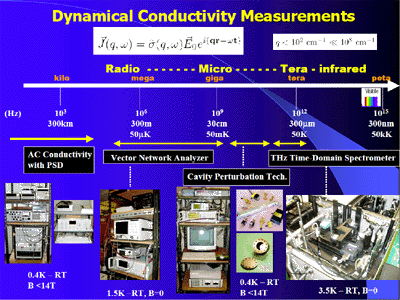Our Research Content
- Research Subjects
-
We are studying the protonic dynamics and phonons in proton conductors with a wide frequency range of electromagnetic waves. From these measurements of protons' response to time- and spacial-dependent electric fields, we can analyze the dynamical conductivity (dynamical dielectricity) dependent on temperature and then fundamental properties of protons phonons are clarified.
Our techniques covering the frequency range from dc up to Tera Hertz are;
1. Low-frequency range (0.01 Hz - 200 kHz) --- phase-sensitive detection using a capacitance bridge, with four (or three) terminals
2. Radio-wave range (300 kHz - 2 GHz) --- reflection measurements of electromagnetic fields with a network analyzer, with two terminals
3. Microwave range (10 GHz - 50 GHz) --- cavity-perturbation technique for measuring the center frequency and the width of standing waves in a cavity, without any terminals
4. Terawave (sub-millimeter waves) range (0.1 THz - 4 THz) --- TDTS (Time-Domain Terahertz Spectroscopy) for simultaneously measuring both the amplitude and phase of transmitted waves.
5. Infrared range (100-8000 cm-1) --- FT-IR spectrometer equipped with Cassegrain microscope.
These different techniques having characteristic features are used for each research subject. To note, any samples can be cooled down to helium temperature independent of the techniques 1-5, and particularly, in 1 and 3, down to 4 K.
So far we have been involved mainly in studying water nanotubes and biological materials. With those apparatus, we are extensively measuring the protonl conductivity for various fuel-cell electrolyte materials.

- Research Methods
- Low and high temperatures
Terahertz measurementInfrared spectrometry
Measurement of low frequency physical property
Microwave and millimeter-wave measurement
- Research Contents
-
Dynamics of confined water and proton conductors
Physical properties of confined water in collagen and chitin films
Hydration and protonic dynamics of fuell-cell materials
Low Dimensional
Quantum Physics Group
Sendai 980-8578, Japan
TEL 81-22-795-6604
FAX 81-22-795-6786
